
Experts in autocracies have pointed out that it is, unfortunately, easy to slip into normalizing the tyrant, hence it is important to hang on to outrage. These incidents which seem to call for the efforts of the Greek Furies (Erinyes) to come and deal with them will, I hope, help with that. As a reminder, though no one really knows how many there were supposed to be, the three names we have are Alecto, Megaera, and Tisiphone. These roughly translate as “unceasing,” “grudging,” and “vengeful destruction.”
By the time you read this, the September 18th event – however big or small it turns out to have been – will be over. But I for one am not naive enough to assume that it will be the last such event – and, even if not in the Capital, such events will no doubt continue happening all over the nation. By “such events” I mean any event designed to show support for Donald Trump** and all his evils in some way (superspreading optional). So I don’t think it’s time wasted to look at some of the symbols being used in these vanity parades. The lesser known ones particularly may be helpful to alert you when you are dealing with a MAGAt.
================================================================
Capitol Police prepare for a return of insurrectionists to Washington – 5 essential reads on the symbols they carried on Jan. 6
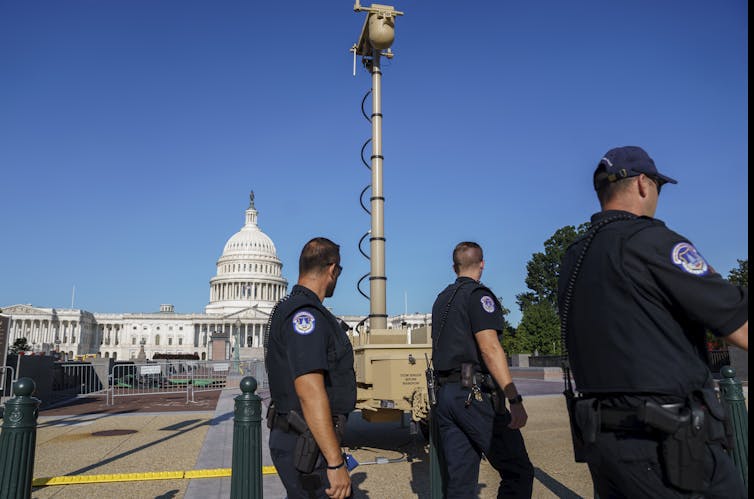
AP Photo/J. Scott Applewhite
A rally in Washington, slated for Sept. 18, 2021, is being billed as an effort to support people who face criminal charges for their involvement in the Jan. 6 insurrection at the U.S. Capitol.
Many of the same groups who participated in January are expected to return to the nation’s capital for this demonstration. Capitol Police are reportedly preparing for violence and erecting protective fencing around the building.
The groups involved in January’s attack on the Capitol carried a variety of political and ideological flags and signs. The Conversation asked scholars to explain what they saw – including ancient Norse images and more recent flags from U.S. history – and what those symbols mean.
Here are five articles from The Conversation’s coverage, explaining what many of the symbols mean.
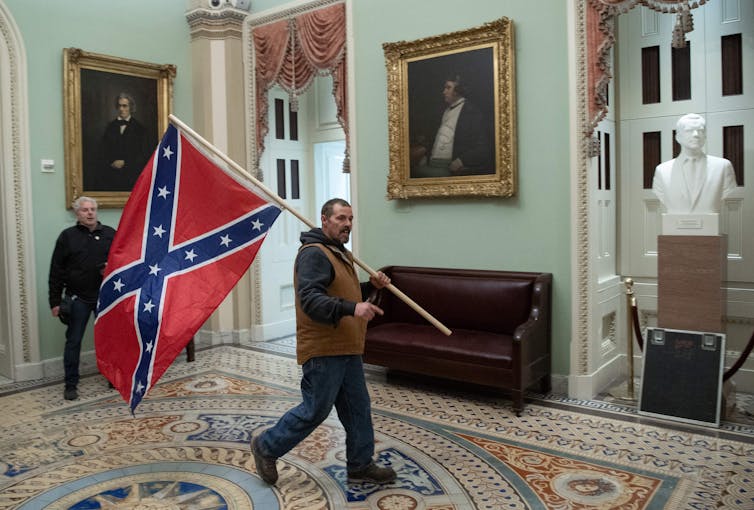
Saul Loeb/AFP via Getty Images
1. The Confederate battle flag
Perhaps the most recognized symbol of white supremacy is the Confederate battle flag.
“Since its debut during the Civil War, the Confederate battle flag has been flown regularly by white insurrectionists and reactionaries fighting against rising tides of newly won Black political power,” writes Jordan Brasher at Columbus State University, who has studied how the Confederacy has been memorialized.
He notes that in one photo from inside the Capitol, the flag’s history came into sharp relief as the man carrying it was standing between “the portraits of two Civil War-era U.S. senators – one an ardent proponent of slavery and the other an abolitionist once beaten unconscious for his views on the Senate floor.”
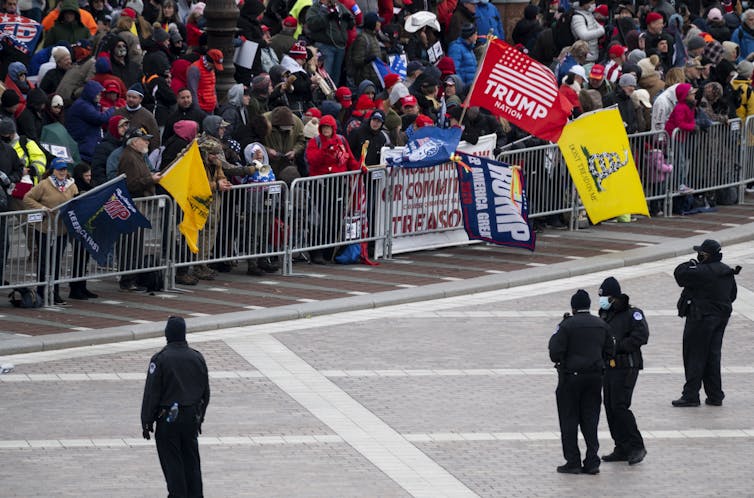
Bill Clark/CQ-Roll Call, Inc via Getty Images
2. The yellow Gadsden flag
Another flag with a racist history is the “Don’t Tread On Me” flag. A symbol warning of self-defense, it was designed by slave owner and trader Christopher Gadsden when the American Revolution began, as Iowa State University graphic design scholar Paul Bruski writes.
“Because of its creator’s history and because it is commonly flown alongside ‘Trump 2020’ flags, the Confederate battle flag and other white-supremacist flags, some may now see the Gadsden flag as a symbol of intolerance and hate – or even racism,” he explains.
It has been adopted by the tea party movement and other Republican-leaning groups, but the flag still carries the legacy, and the name, of its creator.
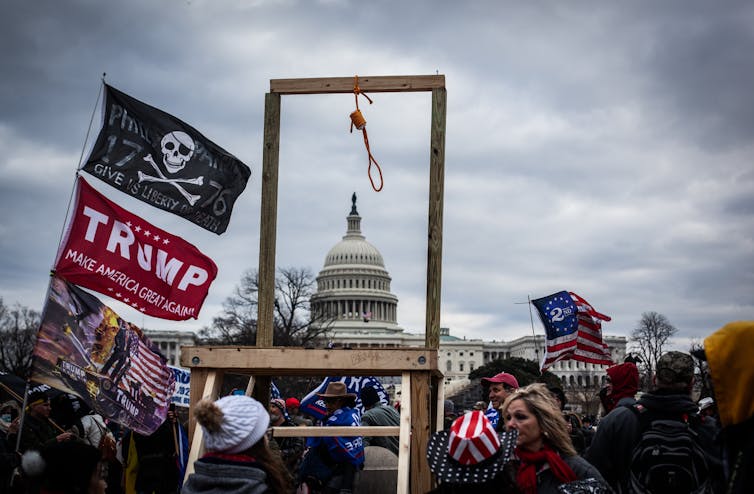
Shay Horse/NurPhoto via Getty Images
3. Powerful anti-Semitism
Another arm of white supremacy doesn’t target Blacks. Instead, it demonizes Jewish people. Plenty of anti-Semitic symbols were on display during the riot, as Jonathan D. Sarna explains.
Sarna is a Brandeis University scholar of American anti-Semitism and describes the ways that “[c]alls to exterminate Jews are common in far-right and white nationalist circles.” That included a gallows erected outside the Capitol, evoking a disturbing element of a 1978 novel depicting the takeover of Washington, along with mass lynchings and slaughtering of Jews.
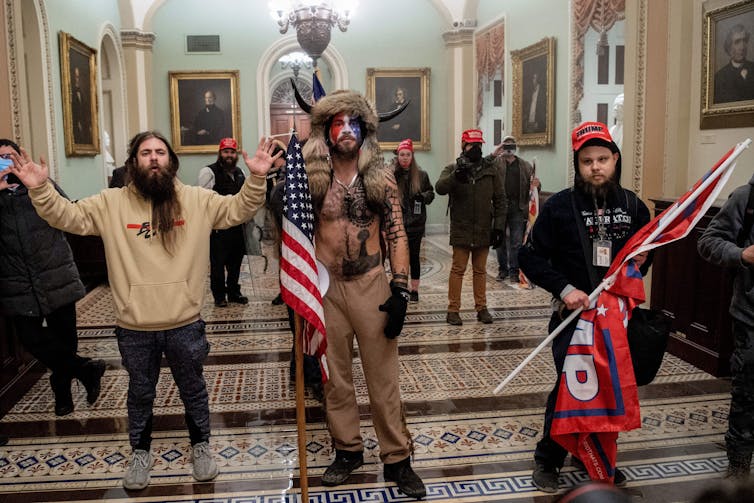
Saul Loeb/AFP via Getty Images
4. Co-opted Norse mythology
Among the most striking images of the January riot were those of a man wearing a horned hat and no shirt, displaying several large tattoos. He is known as Jake Angeli, but his full name is Jacob Chansley, and he has pleaded guilty to one of six charges as part of a plea deal for his role in the riot.
Tom Birkett, a lecturer in Old English at University College Cork in Ireland, explains that many of the symbols Chansley wore are from Norse mythology. However, he explains, “These symbols have also been co-opted by a growing far-right movement.”
Birkett traces the modern use of Norse symbols back to the Nazis and points out that they are a form of code hidden in plain sight: “If certain symbols are hard for the general public to spot, they are certainly dog whistles to members of an increasingly global white supremacist movement who know exactly what they mean.”
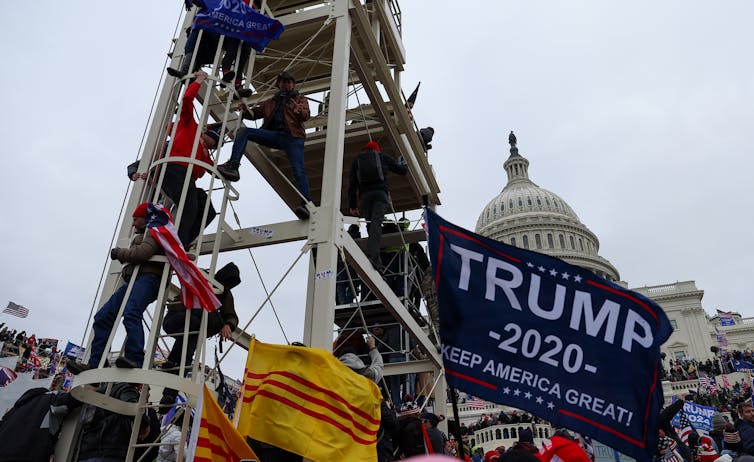
Tayfun Coskun/Anadolu Agency via Getty Images
5. An outlier, of sorts
Another flag was prominent at the Capitol riot, one that doesn’t strictly represent white supremacy: the flag of the former independent country of South Vietnam.
But Long T. Bui, a global studies scholar at the University of California, Irvine, explains that when flown by Vietnamese Americans, many of whom support Trump, the flag symbolizes militant nationalism.
“[S]ome Vietnamese Americans view their fallen homeland as an extension of the American push for freedom and democracy worldwide. I have interviewed Vietnamese American soldiers who fear American freedom is failing,” he explains.
Editor’s note: This story is a roundup of articles from The Conversation’s archives and is an update of an article previously published on Jan. 15, 2021.![]()
Jeff Inglis, Politics + Society Editor, The Conversation
This article is republished from The Conversation under a Creative Commons license. Read the original article.
================================================================
Alecto, Megaera, and Tisiphone, Some of these may be more accurate than those so proudly flashing them have bargained for. The Gadsden flag in particular I consider highly appropriate, implying, as it does, that the carrier or wearer is a snake. The Odinistic symbols are harder to spot, although I have seen at least one person wearing a Thor’s Hammer necklace. The flag of South Vietnam is a real surprise to me – but then, no one should be surprised that they misappropriate symbols – they do everything else.
The Furies and I will be back.
